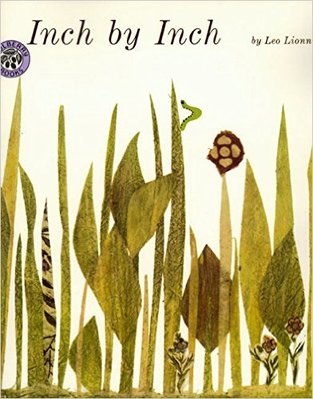INCH BY INCH
Author: Leo Lionni
Illustrator: Leo Lionni
|
Number of pages: 32
Publisher: William Morrow (USA) First published in: 1960 Format: Picturebook Is the mathematical focus explicit in the story? Yes Is this story part of a mathematics story series? No Preview and/or purchase this book on the Amazon websites: UK, USA, AUS, IND, CAN Synopsis by the author/publisher
A small green inchworm is proud of his skill at measuring anything—a robin’s tail, a flamingo’s neck, a toucan’s beak. Then one day a nightingale threatens to eat him if he cannot measure his song. Children will enjoy the clever inchworm’s solution and delight in finding the tiny hero on every page. |
“"Don't eat me. I am an inchworm. I am useful. I measure things." "Is that so!" said the robin. "Then measure my tail!" "That's easy," said the inchworm. "One, two, three, four, five inches." "Just think," said the robin, "my tail is five inches long!"”
Official review by MathsThroughStories.org:
Leo Lionni’s ‘Inch by Inch’ (1960) is a story about an inchworm who avoids being gobbled up by a hungry robin by offering to measure things for the bird. First, the robin tells the inchworm to measure its tail. The inchworm then promptly makes five loops across the entire length of the robin’s tail. As every loop he takes is one inch, the inchworm declares the tail to be five inches long. The inchworm is then told to also measure body parts of the robin’s friends: a flamingo’s neck, a toucan’s beak, a heron’s legs, a pheasant’s tail and a hummingbird’s body. Later, the inchworm gets an impossible task - being asked to measure a song sung by a nightingale. Can the inchworm outsmart the nightingale to get his freedom back? The story provides a lovely context to introduce children to the concept of measurement, particularly the use of non-standard units. Once the story is read to the children, we can see, for example, children are encouraged to use plastic worms or any other short objects in the class or at home (e.g. short pencils) to measure bigger items, such as a desk or a chair. Then, we can see the children being encouraged to compare their results with those of their peers or siblings to see if, for example, measuring a chair using a plastic worm and a short pencil will give the measurement. The story also provides an opportunity for children to think about whether we can use the same length measurement units to measure things that they cannot touch like time. All in all, we very much highly recommend ‘Inch by Inch’ to introduce the concept of measurement to children, aged 6+ years old. It may be worth noting that the author later wrote a story called ‘Pezzettino’ (1975), which does not have an explicit mathematical focus, but with some creative thinking from teachers and parents, it can be turned into a handy introduction to fraction for young children.
Recommended age range:
6+ years old
Relevant mathematics topics:
Length & Distance
Possible teaching activities:
At MathsThroughStories.org, we believe that stories can be meaningfully incorporated in mathematics teaching in different ways. Thus, we are inviting you to share your experience of how you have used this story in your mathematics lesson with other members of the community. By sharing your experience with us, you will be added to our team of On-line Contributors here, where you can also find our submission guideline.
Leo Lionni’s ‘Inch by Inch’ (1960) is a story about an inchworm who avoids being gobbled up by a hungry robin by offering to measure things for the bird. First, the robin tells the inchworm to measure its tail. The inchworm then promptly makes five loops across the entire length of the robin’s tail. As every loop he takes is one inch, the inchworm declares the tail to be five inches long. The inchworm is then told to also measure body parts of the robin’s friends: a flamingo’s neck, a toucan’s beak, a heron’s legs, a pheasant’s tail and a hummingbird’s body. Later, the inchworm gets an impossible task - being asked to measure a song sung by a nightingale. Can the inchworm outsmart the nightingale to get his freedom back? The story provides a lovely context to introduce children to the concept of measurement, particularly the use of non-standard units. Once the story is read to the children, we can see, for example, children are encouraged to use plastic worms or any other short objects in the class or at home (e.g. short pencils) to measure bigger items, such as a desk or a chair. Then, we can see the children being encouraged to compare their results with those of their peers or siblings to see if, for example, measuring a chair using a plastic worm and a short pencil will give the measurement. The story also provides an opportunity for children to think about whether we can use the same length measurement units to measure things that they cannot touch like time. All in all, we very much highly recommend ‘Inch by Inch’ to introduce the concept of measurement to children, aged 6+ years old. It may be worth noting that the author later wrote a story called ‘Pezzettino’ (1975), which does not have an explicit mathematical focus, but with some creative thinking from teachers and parents, it can be turned into a handy introduction to fraction for young children.
Recommended age range:
6+ years old
Relevant mathematics topics:
Length & Distance
Possible teaching activities:
At MathsThroughStories.org, we believe that stories can be meaningfully incorporated in mathematics teaching in different ways. Thus, we are inviting you to share your experience of how you have used this story in your mathematics lesson with other members of the community. By sharing your experience with us, you will be added to our team of On-line Contributors here, where you can also find our submission guideline.

